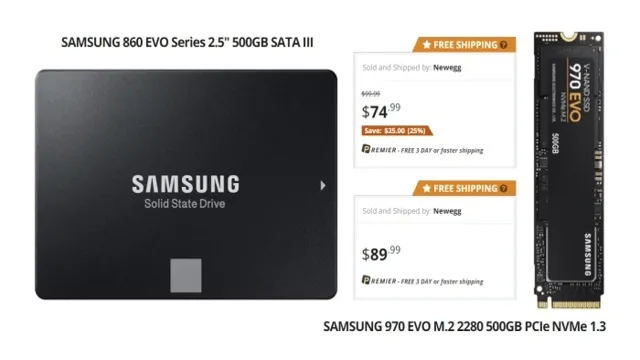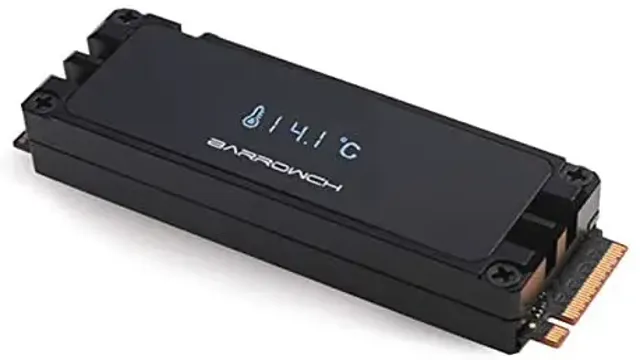Are you considering upgrading your computer’s storage to an NVMe SSD? If so, you may be wondering whether or not you need a heatsink. After all, NVMe SSDs are known for their lightning-fast speeds and powerful performance, but do they run hot enough to warrant additional cooling? In this blog post, we’ll dive into the topic of NVMe SSD heatsinks and explore whether or not they’re necessary for optimal performance. So, sit back, relax, and get ready to learn everything you need to know about NVMe SSD heatsinks.
Understanding NVMe SSDs
While it’s not necessary for NVMe SSDs to have heatsinks, they can certainly benefit from them. NVMe SSDs are known for their speedy performance and have become increasingly popular among gamers and professionals alike. However, with great power comes great heat, and that applies to these drives as well.
In some cases, NVMe SSDs can get very hot, especially when under heavy load. A heatsink can help dissipate this heat and prevent thermal throttling, which can affect performance and even cause damage to the drive over time. It’s important to note that not all NVMe SSDs require heatsinks, and it’s ultimately up to the user to determine whether their drive needs one.
If you’re running intense workloads or want to ensure the longevity of your NVMe drive, investing in a heatsink may be a wise choice.
Why NVMe SSDs Run Hot
If you are wondering why NVMe SSDs run hot, the simple answer is that they tend to generate more heat compared to traditional hard drives. This is because NVMe SSDs use flash storage technology and have little to no moving parts, which results in less power consumption and faster data transfer speeds, but also generates higher temperatures. NVMe SSDs also tend to run hot when under heavy workloads or during prolonged use.
To avoid overheating, it is crucial to ensure proper airflow in your device’s casing and invest in a high-quality cooling system. While the high operating temperatures of NVMe SSDs may seem concerning, it is important to note that this is not necessarily a cause for alarm and is often within acceptable limits. Furthermore, NVMe SSDs come with built-in temperature sensors and thermal management features to prevent overheating and ensure that they continue to perform optimally.

Effects of Heat on Performance and Longevity
NVMe SSDs NVMe SSDs are designed to deliver blazing-fast speeds and outstanding performance, and they’re quickly becoming more popular than traditional hard drives. However, when it comes to NVMe SSDs, heat can be a big issue that affects both performance and longevity. If the temperature of an NVMe SSD gets too high, it can cause data errors, slow down performance, and even shorten the lifespan of the drive.
Therefore, it’s essential to understand how your NVMe SSD is affected by heat and take steps to manage it. One way to keep your NVMe SSD cooler is to ensure that your computer has proper ventilation and airflow. Another way is to consider investing in a thermal pad or heatsink to help dissipate heat.
By understanding the effects of heat on your NVMe SSD and taking proactive steps to manage it, you can ensure that your drive runs smoothly, performs at its best, and lasts as long as possible.
Factors that Determine the Need for Heatsinks
When it comes to NVMe SSDs, the need for heatsinks depends on a few factors. Firstly, the size and type of the SSD can play a role. Larger SSDs tend to generate more heat due to the amount of data they store, while certain types of SSDs like TLC or QLC also produce more heat.
Additionally, the workload on the SSD can impact whether or not a heatsink is necessary. If the SSD is being used for intensive tasks like gaming or video editing, it may require a heatsink to keep it cool. Lastly, the environment in which the SSD is being used can also influence the need for a heatsink.
If the computer is in a warm or poorly ventilated room, a heatsink may be necessary to prevent overheating and potential performance issues. Overall, it’s important to consider these factors when determining whether or not an NVMe SSD needs a heatsink.
Capacity of the NVMe SSD
The capacity of an NVMe SSD has been increasing over the recent years, providing faster performance for storage devices. However, the need for heatsinks to cool down the drives is becoming increasingly important as the capacity and speeds increase. The factors that determine whether or not the NVMe SSD requires a heatsink includes the size of the SSD, the workload for which it is being used, and the ambient temperature of the environment in which it is operating.
A larger SSD typically generates more heat and requires more cooling, especially if it is being used for high-end applications such as gaming or video editing. Moreover, workloads that involve constant reading and writing can also generate additional heat and require the use of heatsinks. In environments with high ambient temperatures, the need for heatsinks is even more crucial.
Without proper cooling, the SSD’s performance can significantly deteriorate and lead to system crashes. Therefore, it is essential to assess the workload and the environment in which the NVMe SSD will operate to determine the necessity of heatsinks.
Type of NVMe SSD
NVMe SSD, heatsinks, factors, need NVMe SSDs come in different types and capacities, and depending on the usage of the drive, the need for heatsinks may vary. Factors that determine the need for heatsinks include the type of NVMe SSD, the size of the drive, and the workload. For instance, high-end NVMe SSDs with larger capacities tend to generate more heat than smaller ones; thus, they require a heatsink to dissipate the heat.
Similarly, if you are using the NVMe SSD for tasks that require heavy workloads, such as gaming or video editing, the drive may generate more heat, and a heatsink can help keep the temperature down. However, if you are using the SSD for light tasks such as browsing the web or office work, the need for a heatsink may not be necessary. Ultimately, the type of NVMe SSD you choose will determine the need for and type of heatsink required.
It is essential to consider these factors when choosing an NVMe SSD to ensure efficient performance and longevity of the drive.
Amount of Airflow in the System
When it comes to deciding whether or not you need heatsinks in your electronic system, the amount of airflow in the system is a crucial factor you need to consider. Heatsinks are designed to dissipate heat away from electronic components to prevent damage and improve performance. If your system has limited airflow, you’ll need heatsinks to efficiently dissipate the heat generated by the components.
Without proper dissipation, the heat can build up and cause the components to overheat, leading to premature failure or reduced lifespan. In contrast, if your system has excellent airflow, you may not require heatsinks since the excess heat can easily be carried away by the air passing over the components. So, if you’re designing or upgrading an electronic system, take the time to evaluate the amount of airflow in your system to determine whether or not you need heatsinks.
Benefits of Adding Heatsinks
Do NVMe SSDs need heatsinks? The answer is not straightforward. NVMe SSDs get hot under heavy loads, and the heat can affect their performance and lifespan. Installing a heatsink can help dissipate the heat and keep your NVMe SSD in top condition.
Overheating can also cause data corruption and system crashes, which can lead to data loss and frustration. Moreover, adding a heatsink can improve the aesthetics of your build and protect your SSD against accidental damage. So, it’s a good idea to invest in a high-quality heatsink if you want to get the most out of your NVMe SSD.
However, not all NVMe SSDs require a heatsink, and some already come with built-in thermal solutions. Therefore, before installing a heatsink, you should check your NVMe SSD’s specifications and the manufacturer’s recommendations. In conclusion, adding a heatsink is not mandatory, but it’s a wise decision to safeguard your data and prolong your SSD’s longevity.
Improved Thermal Management
Adding heatsinks is a smart way to improve your electronic device’s thermal management. The benefits of heatsinks include better heat dissipation, reduced operating temperatures, and longer lifespan of electronic components. Heatsinks work by increasing the surface area of the device to transfer heat away from the internal components.
This extra surface area makes it easier for the heat to escape, ensuring the device does not overheat and malfunction. Without sufficient thermal management, electronic components can quickly become damaged or even cause a fire. With heatsinks, you can extend the life of your device, improve its performance, and avoid costly repairs or replacements.
So, consider adding heatsinks to your electronic device, and enjoy the benefits of improved thermal management.
Extended SSD Lifespan
Adding heatsinks to your SSD can significantly extend its lifespan and prevent overheating, ultimately resulting in a better performance. SSDs generate a considerable amount of heat during their operation, which can lead to thermal throttling and reduce their longevity. Installing heatsinks can act as a thermal regulator to dissipate the excess heat from the components and prevent them from reaching high temperatures.
This process can help to protect the SSD’s flash memory, as well as the controller, which both have a limited lifespan. A cooler SSD will also operate more efficiently and faster than a hot one. Another benefit of heatsinks is that they can prevent damage to other components in your system since overheated SSDs may cause damage to motherboards or other components.
Invest in heatsinks for your SSD, and you can enjoy a faster, more reliable, and extended lifespan of your solid-state drive.
Conclusion: To Heat Sink or Not to Heat Sink
In the end, the question of whether NVMe SSDs need heatsinks is as complex as it is simple. The truth is, it depends on a number of factors such as the workload, system configuration, and personal preference. While NVMe SSDs are certainly capable of generating heat, there’s no single answer that fits all situations.
So, whether you decide to invest in a heatsink or not, one thing is certain – you’ll always have a hot topic to debate in the tech community.”
FAQs
What are NVMe SSDs?
NVMe (Non-Volatile Memory express) SSDs are the latest storage technology that delivers high-speed data transfer and fast boot times in modern devices.
Why do NVMe SSDs require heatsinks?
NVMe SSDs generate heat while working, and heatsinks are necessary to dissipate this heat and prevent the SSD from overheating, which can lead to slowdowns and system crashes.
How do I know if my NVMe SSD needs a heatsink?
If you are experiencing slow performance or frequent system crashes, it might suggest that your NVMe SSD is getting too hot and needs a heatsink. You can also check your manufacturer’s guidelines or consult a technician for advice.
What are the benefits of using a heatsink on my NVMe SSD?
A heatsink can significantly enhance the performance and lifespan of your NVMe SSD by maintaining cooler operating temperatures and preventing overheating, reducing the risk of data loss and system crashes. It can also aid in maintaining peak performance even when the device is under heavy load.
Can I install a heatsink on my NVMe SSD by myself?
Technically, yes, you can install a heatsink on your NVMe SSD by yourself, but it’s not recommended. As a small mistake can damage the SSD, you may want to take the help of a professional technician who will perform the installation safely and correctly.
